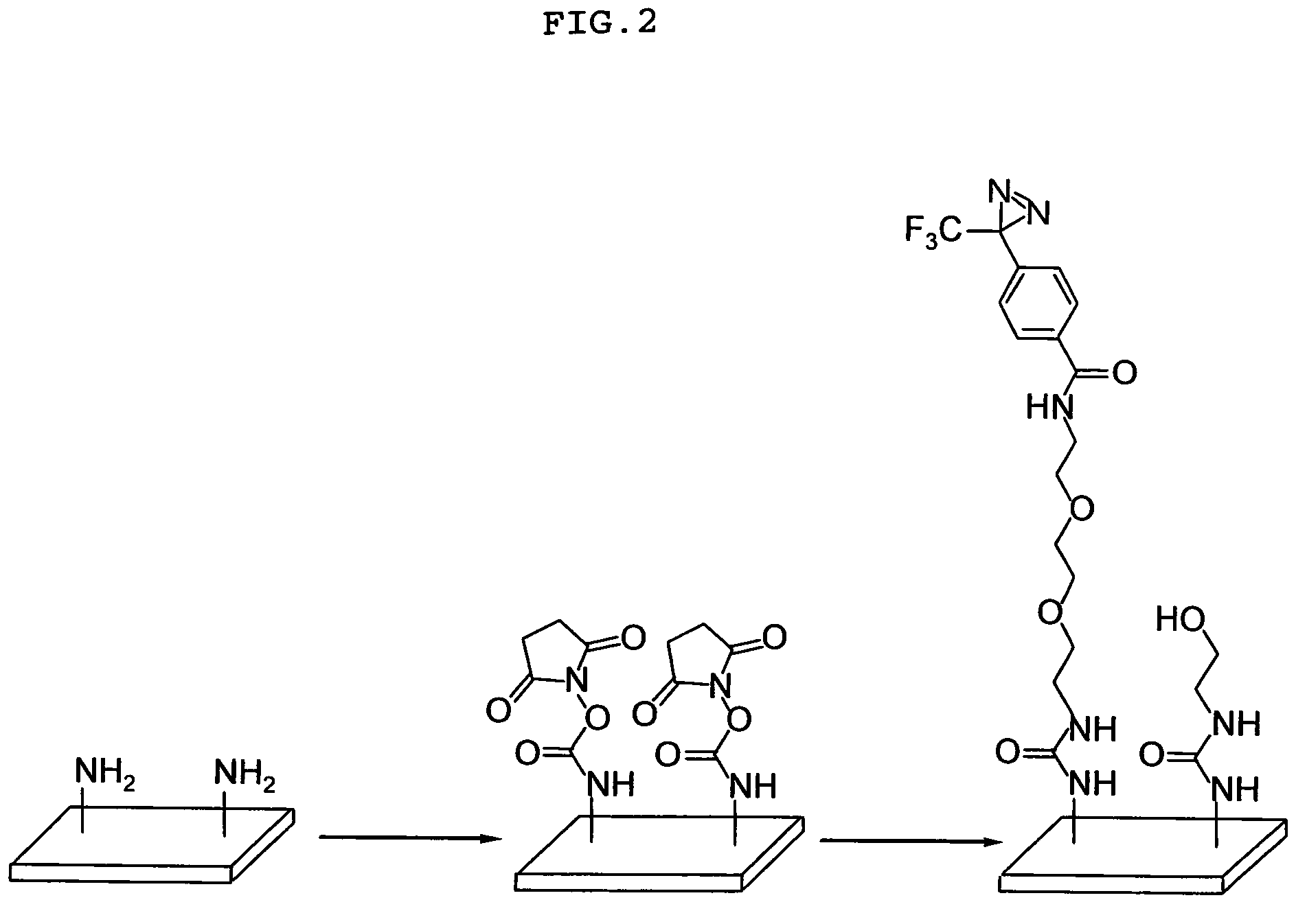Method of fixing low-molecular compound to solid-phase support
a technology of solid-phase support and low-molecular compound, which is applied in the field of fixing low-molecular compound on solid-phase support, can solve the problem of arraying a class of synthetic combinatorial library compound
- Summary
- Abstract
- Description
- Claims
- Application Information
AI Technical Summary
Benefits of technology
Problems solved by technology
Method used
Image
Examples
example 1
Introduction of Polyethylene Glycol Linker into Photophilic Atomic Group
[0079]To a solution of 4-(3-trifluroemthyl-3H-diazirin-3-yl)-benzoic acid (Compound A) (17.9 mg, 72.0 μmol), [2-[2-(2-amino-ethoxy)-ethoxy]-ethyl]-carbamic acid tert-butyl ester (Compound B) (73.8 mg, 297 μmol, 4.1 eq.) and N,N-dimethylaminopyridine (3.1 mg, 25.4 μmol, 0.35 eq.) in dry THF (1 mL) was added 1-[3-(dimethylamino)propyl]-3-ethylcarbodiimide hydrochloride (24.1 mg, 126 μmol, 1.7 eq.) at room temperature. The solution was stirred in the dark for 20 hours. The solvent was evaporated under reduced pressure, and the residue was purified by silica gel chromatography (1 g, chloroform:methanol=25:1) to yield 27.6 mg (59.9 μmol, yield:83%) of [2-(2-[2-[4-(3-trifluoromethyl-3H-diazirin-3-yl)-benzoylamino]-ethoxy]-ethoxy)-ethyl]-carbamic acid tert-butyl ester (Compound C).
[0080]The resulting Compound C (27.6 mg, 59.9 mol) was dissolved in dichloromethane (1 mL) and trifluoroacetic acid (150 μL) and stirred at ...
example 2
Modification of Glass Support
[0085]A mixed solution of N,N′-disuccinimidyl carbonate (74.2 mg,290 μmol), N,N-diisopropylethylamine (48 mL, 276 μmol) and DMF (600 μL) was added onto a aminated slide glass [a coated slide glass for DNA microarray (high density amino group-introduced type 1 slide), 76×26 mm; Matsunami Glass Ind. Ltd.] at a rate of 0.18 μL / mm2 , and then treated at room temperature for 16 hours. The treated slide glass was washed with ethanol, deionized water, ethanol and deionized water in this order for 10 minutes each, dehydrated in a dehydration centrifuge (400×g) for 1 minute, and further dried in vacuo to give a succinimidylated slide.
[0086]Onto the resulting succinimidylated slide, a mixed solution of N-[2-[2-(2-amino-ethoxy)-ethoxy]-ethyl]-4-(3-trifluoromethyl-3H-diazir in-3-yl)-benzamido trifluoroacetate (Compound D) (17.4 mg, 37.7 μmol), N,N-diisopropylamine (40 μL, 230 μmol) and DMF (360 μL) was added at a rate of 0.11 μL / mm2, and then treated in the dark at ...
example 3
Fixing of Low-Molecular Compound
[0087]On the photophilic atomic group-introduced slide, 0.2 μL of each of solutions of low-molecular compounds (biotin, rhodamine B, digoxin) in DMSO, which had been prepared in concentrations of 100, 10, 1, 0.1 and 0.01 mM, was spotted. The slide was dried in an incubator at 35° C. for 3 hours and further dried with a vacuum pump for 20 hours. The slide was irradiated with ultraviolet ray having a wavelength of 365 nm for 30 minutes, and then excess low-molecular compound which failed to be fixed to the slide was washed out with ethanol. The slide was then washed while shaking by immersing in ethanol, DMF, THF, ethanol and deionized water in this order (for 1 hour each). Thus, a slide on which low molecules were fixed was produced.
[0088]The structures of biotin, digoxin and rhodamine B are shown below.
[0089]
PUM
| Property | Measurement | Unit |
|---|---|---|
| molecular weight | aaaaa | aaaaa |
| molecular weight | aaaaa | aaaaa |
| molecular weight | aaaaa | aaaaa |
Abstract
Description
Claims
Application Information
 Login to View More
Login to View More - R&D
- Intellectual Property
- Life Sciences
- Materials
- Tech Scout
- Unparalleled Data Quality
- Higher Quality Content
- 60% Fewer Hallucinations
Browse by: Latest US Patents, China's latest patents, Technical Efficacy Thesaurus, Application Domain, Technology Topic, Popular Technical Reports.
© 2025 PatSnap. All rights reserved.Legal|Privacy policy|Modern Slavery Act Transparency Statement|Sitemap|About US| Contact US: help@patsnap.com



